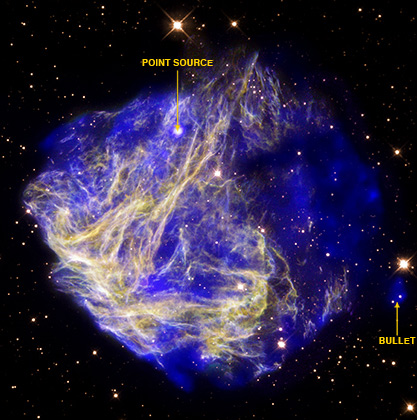
The new image from NASA's Chandra X-ray Observatory shows N49, the aftermath of a supernova explosion in the Large Magellanic Cloud, a dwarf galaxy that neighbors our own Milky Way.
The cosmic bullet in the scene was caught when astronomers used Chandra for over 30 hours to get a long exposure. [Gallery - The X-ray Universe.]
The bullet, which suggests a highly asymmetric explosion, is traveling at a high speed of about 5 million mph (8 million kph) away from a bright point source in the upper left part of N49. This bright source may be a so-called soft gamma-ray repeater (SGR), a source that emits bursts of gamma-rays and X-rays.
A leading explanation for these objects is that they are neutron stars with extremely powerful magnetic fields. Since neutron stars are often created in supernova explosions, an association between SGRs and supernova remnants is not unexpected.
This case is strengthened by the apparent alignment between the bullet's path and the bright X-ray source.
However, the new Chandra observations also show that the bright source is more obscured by gas than expected if it really lies inside the supernova remnant. In other words, it is possible that the bright X-ray source actually lies beyond the remnant and is projected along the line of sight.
Another possible bullet is located on the opposite side of the remnant, but it is harder to see in the image because it overlaps with the bright emission from the shock-cloud interaction - the yellow and purple parts of the image (from Hubble Space Telescope data). These regions are bright filaments where the shock wave generated by the supernova is interacting with the densest regions in nearby clouds of cool, molecular gas.
The new Chandra photo suggests that the age of N49 - as it appears in the image - is about 5,000 years old, and the energy of the explosion is estimated to be about twice that of an average supernova.
These preliminary results suggest that the original explosion was caused by the collapse of a massive star.
The research and new Chandra image were presented at the 216th meeting of the American Astronomical Society in Miami, Fla.



Reader Comments
to our Newsletter